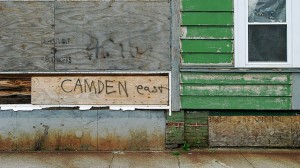This article was originally published on TruthDig.
I park my car in the lot in front of the rectory of Sacred Heart in Camden, N.J., and walk through a gray drizzle to Emerald Street. My friend Lolly Davis, whose blood pressure recently shot up and whose kidneys shut down, had been taken to a hospital in an ambulance but was now home. I climb the concrete steps to her row house and ring the bell. There is an overpowering stench of garbage in the street. Her house is set amid other brick and wooden residences, some of which have been refurbished under Monsignor Michael Doyle’s Heart of Camden project at Sacred Heart, a Roman Catholic parish. Other structures on Davis’ street sit derelict or bear the scars of decay and long abandonment.
Lolly’s grandson, nicknamed Boom Boom or Boomer, answers the door. He tells me his grandmother is upstairs. I enter and sit on a beige chair in the living room near closed white blinds that cover the window looking out on Emerald Street. The living room has a large flat screen television and two beige couches with brown and burnt-red floral patterns that match the chair. There is a stone fireplace with a mantel crowded with family photos. Her grandson, one of numerous children from the neighborhood whom she adopted and raised, yells upstairs to let Lolly know I have arrived.
Lolly, 69, appears at the top of the stairs. Clutching the railing, she makes her way gingerly down the steep wooden steps. Boomer, who is 21 and recently completed a special education program at a high school, goes back to the kitchen, where he was making himself a peanut butter and jelly sandwich. Lolly’s two Chihuahuas, Big Pepsi Cola and Little Pepsi Cola, father and son who get into frequent growling matches, scamper around the room.
I have interviewed Lolly several times over the past two years for the new book, Days of Destruction, Days of Revolt, that I wrote with the cartoonist Joe Sacco. In the book, Joe, who also spent time with her, illustrates the story of Lolly’s life. Lolly radiates the indomitable and magnificent strength of the women and men who rise up in the pockets of poverty and despair we reported from, whether in Camden, Pine Ridge, S.D., the coal fields of southern West Virginia or the produce fields in Florida. They resist not because they will succeed in reversing the corporate onslaught against them, or even save themselves or their communities from poverty, but because it is right. They wake each day to defy, often in small, unseen acts of revolt, the intractable poverty, the despair and violence, by nurturing life. They often can do little to protect the lives, especially the lives of children, that are daily crushed and destroyed. But they refuse to bow before the forces of oppression or neglect. And in that defiance they achieve grandeur.
“The poor have to help the poor,” Lolly says, “because the ones who make the money are helping the people with money.”
Camden’s plight is worse than that of Youngstown, Ohio, or Detroit, worse than that of east New York or Watts. It is a dead city. It makes and produces nothing. It is the poorest city in the United States and is usually ranked year after year as one of the most, and often the most, dangerous. Camden is one of our many internal colonies in North America beset with the familiar corruption and brutal police repression that characterize the despotic regimes I covered as a reporter in Africa and Latin America. The per capita income in the city is $11,967, and nearly 40 percent of the residents live below the poverty line.
Large swaths of Camden lie empty and abandoned. There are more than 1,500 derelict, abandoned row houses, empty shells of windowless brick factories and gutted and abandoned gas stations. There are overgrown vacant lots filled with garbage and old tires and rusted appliances. There are neglected, weed-filled cemeteries and boarded-up storefronts. There are perhaps a hundred open-air drug markets, most run by gangs such as the Bloods, the Latin Kings, Los Nietos and MS-13 (Mara Salvatrucha). Knots of young Hispanic or African-American men in black leather jackets, who can occasionally be seen flipping through wads of cash, sell weed, dope and crack to customers, many of whom drive in from the suburbs, in brazen defiance of the law. The drug trade is perhaps the city’s only thriving business. A weapon is never more than a few feet away from the drug set, usually stashed behind a trash can, in the grass or on a porch, always within easy reach. Camden is a city awash in guns, easily purchased across the river in Philadelphia, where Pennsylvania gun laws are lax. The guns are kept for protection from rival gangs that send out groups to prey on rival drug dealers, stealing their drugs and cash. To be poor is to face the awful fact that nonviolence is a luxury that few on the streets can afford.
When Joe and I were working on the book in Camden a federal grand jury charged a local cop nicknamed “Fat Face” and some of his colleagues with planting drugs on suspects, bribing prostitutes with drugs for information, lying on police reports, beating up suspects and conducting searches without warrants. Three of the city’s mayors have gone to prison for corruption in the last couple of decades. The school system and the police department have been taken over by the state. The deeper the descent the more the criminal class and the city authorities become indistinguishable, a smaller version of what has been replicated by corporations across the nation. Camden may have an African-American mayor, just as America may have an African-American president, but the faces and races of political leaders are no impediment to the ruthless cannibalizing of the country by corporate capitalism.



